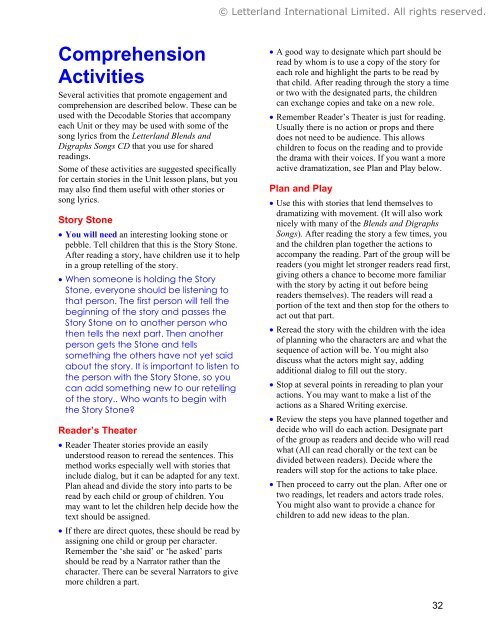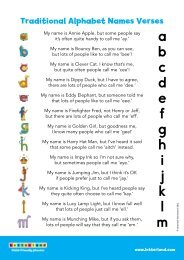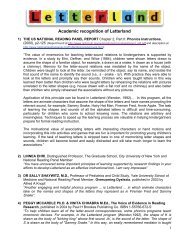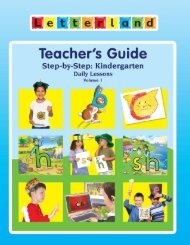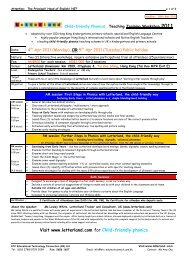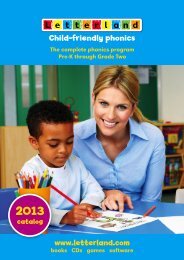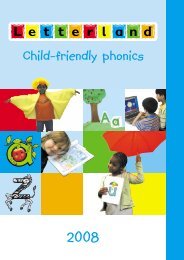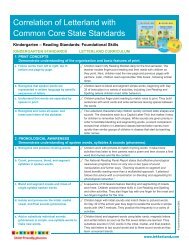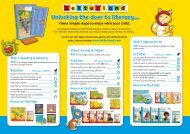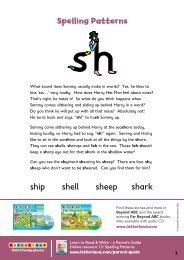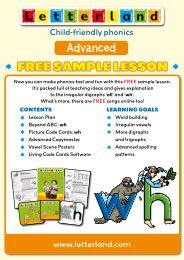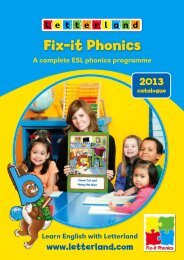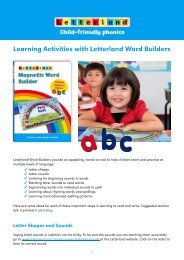Teacher's Guide - Letterland
Teacher's Guide - Letterland
Teacher's Guide - Letterland
Create successful ePaper yourself
Turn your PDF publications into a flip-book with our unique Google optimized e-Paper software.
© <strong>Letterland</strong> International Limited. All rights reserved.ComprehensionActivitiesSeveral activities that promote engagement andcomprehension are described below. These can beused with the Decodable Stories that accompanyeach Unit or they may be used with some of thesong lyrics from the <strong>Letterland</strong> Blends andDigraphs Songs CD that you use for sharedreadings.Some of these activities are suggested specificallyfor certain stories in the Unit lesson plans, but youmay also find them useful with other stories orsong lyrics.Story Stone• You will need an interesting looking stone orpebble. Tell children that this is the Story Stone.After reading a story, have children use it to helpin a group retelling of the story.• When someone is holding the StoryStone, everyone should be listening tothat person. The first person will tell thebeginning of the story and passes theStory Stone on to another person whothen tells the next part. Then anotherperson gets the Stone and tellssomething the others have not yet saidabout the story. It is important to listen tothe person with the Story Stone, so youcan add something new to our retellingof the story.. Who wants to begin withthe Story Stone?Reader’s Theater• Reader Theater stories provide an easilyunderstood reason to reread the sentences. Thismethod works especially well with stories thatinclude dialog, but it can be adapted for any text.Plan ahead and divide the story into parts to beread by each child or group of children. Youmay want to let the children help decide how thetext should be assigned.• If there are direct quotes, these should be read byassigning one child or group per character.Remember the ‘she said’ or ‘he asked’ partsshould be read by a Narrator rather than thecharacter. There can be several Narrators to givemore children a part.• A good way to designate which part should beread by whom is to use a copy of the story foreach role and highlight the parts to be read bythat child. After reading through the story a timeor two with the designated parts, the childrencan exchange copies and take on a new role.• Remember Reader’s Theater is just for reading.Usually there is no action or props and theredoes not need to be audience. This allowschildren to focus on the reading and to providethe drama with their voices. If you want a moreactive dramatization, see Plan and Play below.Plan and Play• Use this with stories that lend themselves todramatizing with movement. (It will also worknicely with many of the Blends and DigraphsSongs). After reading the story a few times, youand the children plan together the actions toaccompany the reading. Part of the group will bereaders (you might let stronger readers read first,giving others a chance to become more familiarwith the story by acting it out before beingreaders themselves). The readers will read aportion of the text and then stop for the others toact out that part.• Reread the story with the children with the ideaof planning who the characters are and what thesequence of action will be. You might alsodiscuss what the actors might say, addingadditional dialog to fill out the story.• Stop at several points in rereading to plan youractions. You may want to make a list of theactions as a Shared Writing exercise.• Review the steps you have planned together anddecide who will do each action. Designate partof the group as readers and decide who will readwhat (All can read chorally or the text can bedivided between readers). Decide where thereaders will stop for the actions to take place.• Then proceed to carry out the plan. After one ortwo readings, let readers and actors trade roles.You might also want to provide a chance forchildren to add new ideas to the plan.32


